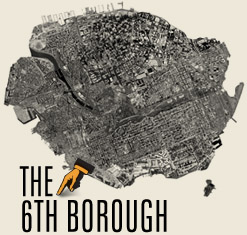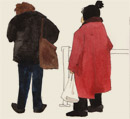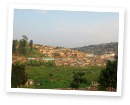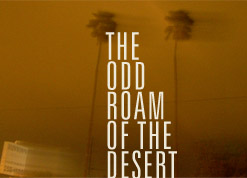’Hoodwinked
by SETH ULLMAN
Neighborhoods have been branded, callously remapping the city like modern-day conquistadors or district-elected majorities. With the salable monikers TriBeCa! East Williamsburg! SoHa! Hunter’s Point South!, we are left with locales assigned strange names that speak perhaps, to projected styles of consumption, architecture, and affluence, but do little to reflect the character of any neighborhood worthy of the label. Not only the places, but the people themselves are imagined without respect for communities and lifestyles that fail to follow the market.
Could neighborhoods develop through the everyday propensity to bounce between careers, to paint walls red, or to cultivate houseplants? What else might these people have in common? Could the perception of rarely noted commonalities encourage that which we actually desire when we think of our ideal neighborhood? I propose that we conceive of neighborhoods not by geographical proximity, but through philosophical affinity.
This blueprint is a little different. I’m not promoting an urban plan, but emphasizing a creative nostalgia from individuals, and networks, that exist beyond the legible. We don’t really need more maps. Information won’t help us reclaim the present. I don’t argue for a new-age global-village utopianism, nor classical Marxist revolution. We need intentional, communicative static.
I believe that we use the idea “neighborhood” nostalgically. Svetlana Boym, an artist and academic, distinguishes a range of reasons for nostalgia, but centers on our grasping for the past as a re-imagining of the present. Nostalgia was first invented by a Swiss doctor in 1688, diagnosing soldiers’ longing for home that was literally making them sick. A soldier might hear a cowbell or consume some specialty of their lost village and only salves of opium and leeches, or ultimately a return home, could bring relief. Perhaps the soldiers were physically longing for the Alps, but this state was surely in dialogue with their present unenviable status as fighters in a foreign land. Boym claims that in a world of ever-increasing demands for productivity and efficiency, culminating in incontestable advantages such as appliance-excellence, we look toward the past, as a means of inspiring our diminishing present. The nostalgic idea of the neighborhood can help us imagine a better future.
It seems to me, that the characteristics that make “neighborhood” an almost-universally appealing concept, are quite often those characteristics we experience as declining in our lives. It is this lack of, and desire for, the local, the supportive, and the richly familiar that drives our aspirations for the neighborhood, whether one that we move toward, by changing location, or a neighborhood that we create, through the tumultuous work of building connections and establishing routines. I want to slow down, cook a meal and expand time just a bit. I want this not as a privilege that is bought, but as one that is collectively built.
A group of people have been working for the past quarter century to create neighborhoods anew. Known as New Urbanists, their ideas are generally market-driving, working to change developers’ practices. The best known New Urbanist development, Celebration, Florida, was created by the Walt Disney Corporation. With an impulse similar to that of New Urbanism, www.walkscore.com aims to map the walkability of neighborhoods for the convenience of Realtors and prospective denizens. It makes this valued characteristic easily legible. Both projects attempt to progressively improve neighborhoods by incorporating aspects traditionally valued in a neighborhood such as public space, walkability and coherence. However, their goals are to be strategically achieved through the housing market. Neighborhoods are bought and sold, pushing some people out, pulling other in, and often quickly changing just those attributes that made the neighborhood so neighborhood-y just months or years previous.
This approach to the neighborhood appears to be propagating exactly that process of hyper-production that created the desire for the past neighborhood in the first place. Who can sit on their porch or stoop and read or visit or drink if the privilege to do so is predicated on an ever-quickening pace of life, and its instigator, cash? How does the good life come to exist beyond advertisements for polo shirts? I know it happens. However, while not all of our dreams of an expansive present remain unrealized, prefabricated nostalgia is unlikely to be sufficient, and perhaps inherently undermines the subtle promises of the concept “neighborhood.”
Svetlana Boym looks at nostalgia and sees two main strains of its deployment. Certainly, nostalgia is often debilitating, amplifying the sorts of dynamics, nationalisms, and naiveté that created the present conditions driving us to seek nostalgia’s guidance. In opposition to this “dictatorship of nostalgia,” she deploys the idea of nostalgic dissidence, the fostering of those values one is listless for, rather than their single-minded, inflexible re-creation. Nostalgia can be a “creative force” rather than a “social disease.”
On the one hand, I want to propose that we illuminate the use of this nostalgia as creative force in our locales. Use the networking power of the Internet to depict the ways that people are creatively expanding the present in our own neighborhoods. We might sketch the relationship between breakfast nooks and after-dinner strolls. Chart explanations of leisurely dynamics flourishing. Perhaps map a city by the average time one spends performing superfluous tasks like preparing dessert. Let’s not just measure how many grills are in a locale’s backyards and parks, but how often they are used.
However, how do I (or we) do this and not risk recreating a Celebration, Florida or Realtor selling point literally in our own backyards? It’s time to imagine strategies for expressing and cultivating leisure that don’t contribute to its forcible migration, or worse, subjugation. Assuming that dissidence and usefulness are not mutually exclusive, how do we maintain dissidence in a useful way? Perhaps it would be better to confuse the neighborhood designations themselves through a proliferation of names for overlapping and non-contiguous spaces. Make it harder to track, to buy, that which is not still. Play with the ways you imagine and talk about your neighborhood. What makes the neighborhood is not tied to the physical space, so much as the actions that make the place there. Live in an autonomous Barbecuing zone. If idle time’s the devil’s workshop, it is also the space of the inventor, the lover and the artist. Let us democratize this form of time, these ways of being.
Basically, to sum so many unnecessary words;
Go have a picnic, it’s Spring.
Svetlana Boym’s in-depth discussion of nostalgia and its political and functional ramifications can be found in her book, “The Future of Nostalgia” published in 2001 by Basic Books. This proposal to picnic owes much of its structure and content to “The Future of Nostalgia.” It is highly recommended Winter reading.
ABOUT
BLUEPRINTS
A New York Moon “Blueprint” is essentially an idea encapsulated in a short amount of words or imagery.
 It is something that could occur to as you ride the subway or right before you fall asleep. The Moon is interested in publishing re-imaginings of the city or world, and proposals that are as much thought experiments as possible creations. For example, if you think the intersection outside your house could be designed better or at least in a way more accomodating to human interaction, draw it and submit it, or photoshop it. On another plane, if you, in a fit of Fourierism, have a novel idea about to organize your building’s daily routine so as to inspire creativity and love, we are all ears and eyes. It is best, perhaps, to read a few blueprints to get a better understanding of how they work.
It is something that could occur to as you ride the subway or right before you fall asleep. The Moon is interested in publishing re-imaginings of the city or world, and proposals that are as much thought experiments as possible creations. For example, if you think the intersection outside your house could be designed better or at least in a way more accomodating to human interaction, draw it and submit it, or photoshop it. On another plane, if you, in a fit of Fourierism, have a novel idea about to organize your building’s daily routine so as to inspire creativity and love, we are all ears and eyes. It is best, perhaps, to read a few blueprints to get a better understanding of how they work.
Submit Blueprints to: newyorkmoon@gmail.com








